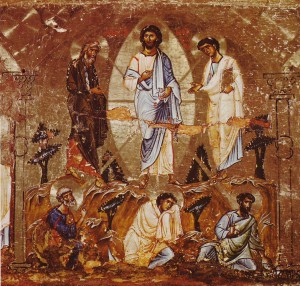![]() “Delivered us from the Domain of Darkness and Transferred us to the Kingdom of His Beloved Son”
“Delivered us from the Domain of Darkness and Transferred us to the Kingdom of His Beloved Son”
The forgiveness of the Gentiles’ sins and entrance into the heavenly kingdom is inextricably linked in Colossians to the Messiah’s triumph over the heavenly rulers and authorities, as they are likewise caught up with him through faith and participation “in Messiah”. Paul refers to Jesus of Nazareth, the Jewish Messiah as “our Lord” (1:2) insinuating that those in Colossae now share the same “Lord” as he himself does. The Messiah has “delivered us from the domain of darkness and transferred us to the kingdom of his beloved Son, in whom we have redemption, the forgiveness of sins (1:13-14).” This language echoes that of God’s deliverance of a people enslaved and their redemption in the Exodus.[1] Those who were “once alienated and hostile in mind, doing evil deeds” (1:21) and “dead in trespasses and the uncircumcision of your flesh” (2:13) have now died to the “στοιχειων του κοσμου” or “elemental spirits of the world” (2:1).
Paul’s narratival understanding of the Messiah-event is cosmically Exodus-shaped. The mystical participation in Jesus’ death and resurrection in baptism (2:12) is understood for Paul as a new Exodus, this time not from Pharaoh, but from the “elemental spirits of the world”. Through the Colossians’ baptism into Messiah, he envisions a very real mystical participation in the new Cosmic Exodus as may be outlined in this way: the purchase of the people from cosmic slavery through participation in his death (1:12) and their being led forth in freedom through participating in his resurrection (1:12).
There has been much debate over the meaning of the phrase “στοιχειων του κοσμου”[2], but after a consideration of its use here within the narratival framework of a new Cosmic Exodus, it may become apparent that these elemental spirits should be understood, as by Wright, in the Jewish apocalyptic tradition as the angels over the nations.[3] The context demands that the “elemental spirits of the world” (2:8, 20) be understand as the “rulers and authorities” (2:10, 15). Through Messiah, God would “reconcile to Himself all things, whether on earth or in heaven, making peace by the blood of His (Messiah’s) cross” (1:20). In the Colossians’ baptism they “have been buried with Him” (2:12) and with Messiah have “died to the elemental spirits of the world”. They were “also raised with Him through faith in the powerful working of God” (2:12) sharing in the exaltation of Him who is “the head of all rule and authority” (2:10). Now they are to let the peace of Messiah rule in their hearts” (3:15). In keeping with the narratival idea of a Cosmic New Exodus in Messiah, the angelomorphic translation and exaltation with Messiah of the “holy ones” in Colossae is not only a rescue from the “domain of darkness” but the superior theotic hope of assuming the role of the inheritors of the cosmos and rulers of the nations, evocative of that previously demonstrated in the Jewish apocalyptic expectation of Daniel and the Wisdom of Solomon.
Participatory Messianism
“In Him the Fullness of Deity Dwells Bodily, and You Have Been Filled in Him”
As it has been demonstrated previously, Paul recognizes those in Colossae to have assumed the title of God’s “holy ones” who look forward to the full enjoyment of their angelomorphic inheritance in light, as well as being delivered from and exalted above their former oppressive regime of angelic patrons; all this is realized due to their faith and participation “in Messiah”. The Participatory Messianism of the apostle to the Gentiles is seen in no greater light than in the expression “For in Him the whole fullness of deity dwells bodily, and you have been filled in him, who is the head of all rule and authority (2:9-10).” As the Messiah Jesus had been filled with deity in bodily form, so those who are in him also share in the fullness of deity.[4] Some commentators regard the language of being “filled” in 2:10 to be rhetorical or hyperbolic if it appeals back to verse 9 and the “fullness of deity”,[5] while others say grammatically it would be asserting too much.[6] The problem with both of these views is that the utilization of the language of “fullness” in 2:9-10 as a deliberate echo of that in the Messiah Hymn of 1:19 must be downplayed or ignored for either to be the case.[7] How to understand the idea of being “filled with deity” may be best explained by the use of what can be recognized as interchangeable expressions for Paul in the same context, especially as aided by the shared nexus of ideas that can be found in early Jewish apocalyptic and mystical literature.
For Paul it is clear that what makes Jesus “Messiah” is his being filled with “the fullness of deity” (1:19). Similarly, it follows that what allows Paul to say the Colossians share “in Messiah” is due to their sharing in “the fullness of deity” (2:9-10). What may be apparent as interchangeable expressions for Paul are those that pertain to glory and enthronement such as: “He is the image of the invisible God” (1:15) and “Messiah in you, the hope of glory” (1:27) as explained further in the subsequent text, “If then you have been raised with Messiah, seek the things that are above, where Messiah is, seated at the right hand of God. Set your mind on things above, not on things of the earth. For you have died and your life is hidden with Messiah in God. When Messiah who is your life appears, then you also will appear with him in glory” (3:1-4). We see contextually a shared nexus of ideas (that of the image of God, the glory, and enthronement) in Jewish apocalyptic and mystical literature that may help to understand what Paul means when he says, “in Him the whole fullness of deity dwells bodily, and you have been filled in him” (2:9-10).
“The Glory of YHWH” in the HB could be understood at any number of angles. In Exodus the “glory” appears to be a hypostasis of God himself: “Come near before YHWH… and behold, the Glory of YHWH appeared in the cloud” (16:9-10). Also in 24:9-17 using all these titles interchangeably: “the Elohim of Israel”, “the cloud”, and “the Glory of YHWH” whose appearance was “like a devouring fire.” Moses in chapter 34 asks of YHWH, “show me your glory” (34:18). God responds saying, “I will make my glory pass before you and proclaim before you my name YHWH” (34:19 LXX). Later in the next chapter recounting what had taken place the author says, “YHWH descended in the cloud and stood with him there… YHWH passed before him” (34:5-6). In chapter 40 you can observe the same pattern of terms used: “the cloud”, “the Glory of YHWH”, “the Cloud of YHWH”, and “the fire” (40:34-38).[8]
Ezekiel portrays “the Glory of YHWH” as an angelomorphic human figure who is enthroned on the Merkabah, the chariot throne of God. In the vision in the first chapter we see one “… seated above the likeness of a throne was a likeness with a human appearance… (a description of his appearance) so was the appearance of the Glory of YHWH. And when I saw it, I fell on my face, and I heard the voice of the one speaking. And he said to me, ‘Son of Man, stand to your feet, and I will speak with you.’ And as he spoke to me, the Spirit entered into me and set me on my feet, and I heard him speaking to me” (1:26, 28-2:2). He speaks with Ezekiel through chapter 2, and then is described again in 3 as “the Glory of YHWH stood there, like the Glory I had seen by the Chebar canal, and I fell on my face” (3:23). The “spirit entering” Ezekiel is what allowed him to stand in “the glory’s” presence and to hear his words (2:2; 3:24).
As scholars have observed, the Ezekiel account of the “Glory of YHWH” may be the backdrop for the vision in Daniel 7. In the vision we notice “with the clouds of heaven there came one like a Son of Man (i.e. human being, possibly with a human appearance), and he came to the Ancient of Days and was presented before him. And to him was given dominion and glory and a kingdom, that all peoples, nations, and languages should serve him” (7:13-14a). When the explanation of the vision in Daniel 7 is given, we find out that the one “like a Son of Man (or human being)” corresponds to (or represents) the “holy ones of the Most High” who “shall receive the kingdom and possess the kingdom forever, forever and ever” (7:18). As it is further stated, “the Ancient of Days came, and judgment was given for the holy ones of the Most High, and the time came when the holy ones possessed the kingdom” (7:22). It is clear that in Daniel the cloud riding one “like a Son of Man (human being)” is seen not only as an individual figure, but shares a corporate identity with the “holy ones of the Most High”.
Another essential component in exploring the understanding of the “glory” is the close correlation with the HB and subsequent Second Temple literatures’ understanding of mankind made in the “image of God”. It is not uncommon to speak of those faithful to the God of Israel throughout history as sharing the “glory”. Wisdom of Jesus ben Sira 44:1 states in reference to the great figures throughout Israel’s history such as Enoch, Noah, Abraham, etc.: “Let us now sing the praises of famous men, our ancestors in their generations. The Lord apportioned to them great glory, his majesty from the beginning.”[9] Proceeding forth five more chapters through the long genealogical list to the end you see expressed “Shem and Seth were honored, but above every other created living being was Adam” (49:16). The implication is that Adam was apportioned a greater glory than any in Israel’s history, or the history of the world for that matter.
In the Greek reception of 3 Baruch, Adam was “stripped of the glory of God” and subsequently men have “become distant from the glory of god” (4:16).[10] Fletcher-Louis discusses what seems to be a liturgical fragment from Qumran, probably preserving a prayer for the first day of the week, acknowledging that Adam was made “in the likeness of Your Glory” (4Q504 fragment 8).[11] In the Life of Adam and Eve, Satan falls because he will not obey a heavenly command to “worship the Image of God” (14:2). Reflecting a high interpretative tradition of texts like Genesis 1:26-27 and Psalm 8, Life of Adam and Eve, along with a great deal of Second Temple Material, see humanity in it’s original form as having an angelomorphic/theotic state, exalting their position over the angels themselves and having heavenly dominion.[12]
We see the “glory” and the Adamic “image of God” meet in texts like 1QH saying God has “raised an eternal [name], [forgiving] offence, casting away all (the community’s) iniquities, giving them as a legacy all the glory of Adam [and] abundance in days” (4:14-15 [17:14-15]).[13] Similarly another text reads “and their descendants forever” possess “all the inheritance of Adam” (4Q171 3:1-2).[14] In other sources we find even possible allusions to the intended purpose of all the hosts and angels is to serve Adam and minister to him (4Q381).[15]
In Colossians, the Messiah is “the image of the invisible God, the firstborn of all creation” (1:15), the Adamic Lord of the Cosmos who restores the Glory of humanity. He is the one in whom “the fullness of deity dwells” (1:19; 2:8) in whom those in Messiah are also “filled”. This is the heavenly “mystery hidden for ages and generations but now revealed to the holy ones” (1:26) that is “Messiah in us, the hope of glory” (1:27). The apocalyptically anointed human being who is the “Glory” and those who are baptized into him are “hidden in God” (3:3). Those being “in Messiah” share in the “fullness of deity” (2:10), redeemed in the Cosmic New Exodus and share “in the inheritance of the holy ones in light” (1:12). When compared with Paul’s opponents, their form of mysticism pales in comparison as to his thoroughly developed Messianic thought: one that could be characterized as Realized Angelomorphic/Theotic Participatory Messianism.
[1] Markus Barth and Helmut Blanke, Colossians: A New Translation with Introduction and Commentary (trans. A. B. Beck; AB 34b; New York: Doubleday, 1994), 190; Dunn, Epistle to the Colossians, 77; Eduard Lohse, Colossians and Philemon (Herm; Philadelphia: Fortress Press, 1971), 36; Margaret Y. McDonald, Colossians and Ephesians (ed. Daniel J. Harrington; SP 17; Collegeville, Minn: Liturgical Press, 2000), 51; Peter T. Obrien, Colossians, Philemon (WBC 44; Waco, TX: Word, 1982), 27; N. T. Wright, The Epistle of Paul to the Colossians and Ephesians: An Introduction and Commentary(TNTC; Leicester, England: Intervarsity Press, 1986), 101-102.
[2] Cf. Arnold, Colossian Syncretism, 158-194; “Returning to the Domain of the Powers: Stoicheia As Evil Spirits in Galatians 4:3,9,” NT 38 (1996): 55-76; Dunn, Epistle to the Colossians, 148-151; Ernest De Witt Burton, A Critical and Exegetical Commentary on the Gospel According to Galatians (Edinburgh: T. & T. Clark, 1921), 515-518; Lohse, Colossians, 96-99; Smith, Heavenly Perspective, 80-87; Wright, Colossians, 101-102.
[3] This is not to say that the actual employment of the term “στοιχειων του κοσμου” is explicit within the context of Second Temple Jewish apocalyptic literature to denote the angels of the nations, but it has been argued elsewhere that the terms scope of meaning could certainly include this concept. Cf. Wright, Colossians, 101-102.
[4] Barth and Blanke, Colossians, 315.
[5] Dunn, Colossians, 152.
[6] O’Brien, Colossians, 113.
[7] It is ironic that in Dunn’s comments on 1:19 he says the idea of the “fullness” presented there is strong enough “to be merging into the idea of incarnation”, and in his comments on 2:9 he recognizes the relationship between 1:19 as he says “the later Christology of ‘divine nature’ and ‘essence’ is clearly prepared for but it by no means yet present” while then saying 2:10’s use is merely rhetorical or hyperbolic. Cf. Dunn, Colossians, 102, 151-152.
[8] Gieschen, Angelomorphic Christology, 78-80.
[9] Fletcher-Louis, All the Glory of Adam, 91.
[10] Ibid., 91.
[11] Ibid., 92.
[12] Cf. David Steenburg, “The Worship of Adam and Christ as the Image of God,” JSNT 39 (1990): 95-109. Steenburg uses his legitimacy principle to attempt to see the origin of the worship of Messiah in Colossians.
[13] Fletcher-Louis, All the Glory of Adam, 96.
[14] Ibid., 96.
[15] Ibid., 98-99.






